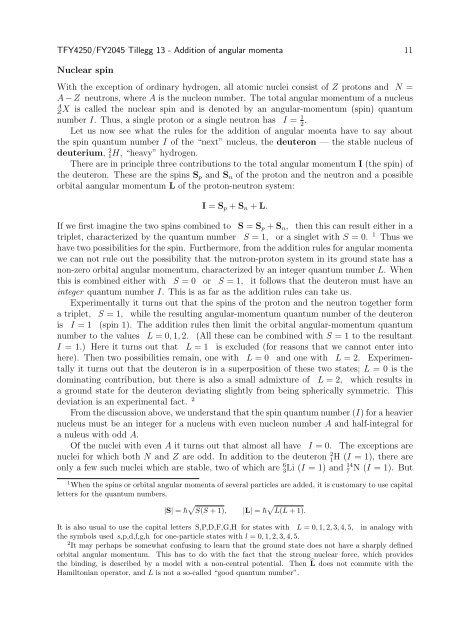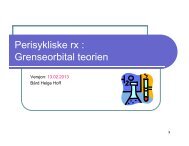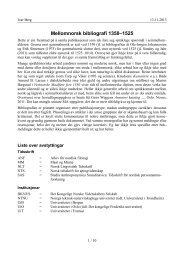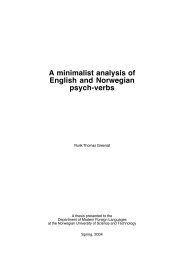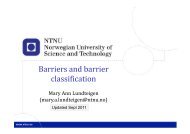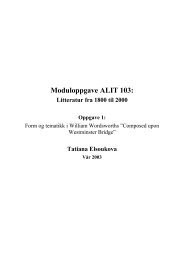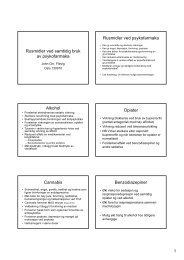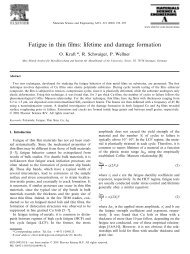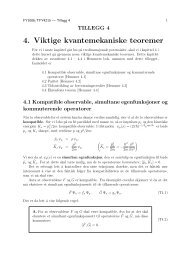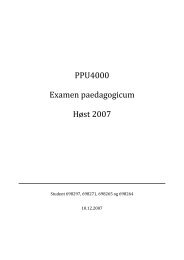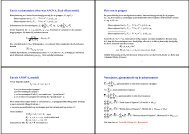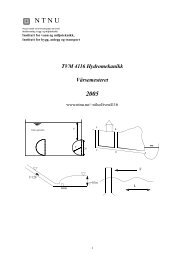Create successful ePaper yourself
Turn your PDF publications into a flip-book with our unique Google optimized e-Paper software.
TFY4250/FY2045 Tillegg <strong>13</strong> - <strong>Addition</strong> <strong>of</strong> <strong>angular</strong> <strong>momenta</strong> 11<br />
Nuclear spin<br />
With the exception <strong>of</strong> ordinary hydrogen, all atomic nuclei consist <strong>of</strong> Z protons and N =<br />
A − Z neutrons, where A is the nucleon number. The total <strong>angular</strong> momentum <strong>of</strong> a nucleus<br />
A<br />
ZX is called the nuclear spin and is denoted by an <strong>angular</strong>-momentum (spin) quantum<br />
number I. Thus, a single proton or a single neutron has I = 1 2 .<br />
Let us now see what the rules for the addition <strong>of</strong> <strong>angular</strong> moenta have to say about<br />
the spin quantum number I <strong>of</strong> the “next” nucleus, the deuteron — the stable nucleus <strong>of</strong><br />
deuterium, 2 1H, “heavy” hydrogen.<br />
There are in principle three contributions to the total <strong>angular</strong> momentum I (the spin) <strong>of</strong><br />
the deuteron. These are the spins S p and S n <strong>of</strong> the proton and the neutron and a possible<br />
orbital a<strong>angular</strong> momentum L <strong>of</strong> the proton-neutron system:<br />
I = S p + S n + L.<br />
If we first imagine the two spins combined to S = S p + S n , then this can result either in a<br />
triplet, characterized by the quantum number S = 1, or a singlet with S = 0. 1 Thus we<br />
have two possibilities for the spin. Furthermore, from the addition rules for <strong>angular</strong> <strong>momenta</strong><br />
we can not rule out the possibility that the nutron-proton system in its ground state has a<br />
non-zero orbital <strong>angular</strong> momentum, characterized by an integer quantum number L. When<br />
this is combined either with S = 0 or S = 1, it follows that the deuteron must have an<br />
integer quantum number I. This is as far as the addition rules can take us.<br />
Experimentally it turns out that the spins <strong>of</strong> the proton and the neutron together form<br />
a triplet, S = 1, while the resulting <strong>angular</strong>-momentum quantum number <strong>of</strong> the deuteron<br />
is I = 1 (spin 1). The addition rules then limit the orbital <strong>angular</strong>-momentum quantum<br />
number to the values L = 0, 1, 2. (All these can be combined with S = 1 to the resultant<br />
I = 1.) Here it turns out that L = 1 is excluded (for reasons that we cannot enter into<br />
here). Then two possibilities remain, one with L = 0 and one with L = 2. Experimentally<br />
it turns out that the deuteron is in a superposition <strong>of</strong> these two states; L = 0 is the<br />
dominating contribution, but there is also a small admixture <strong>of</strong> L = 2, which results in<br />
a ground state for the deuteron deviating slightly from being spherically symmetric. This<br />
deviation is an experimental fact. 2<br />
From the discussion above, we understand that the spin quantum number (I) for a heavier<br />
nucleus must be an integer for a nucleus with even nucleon number A and half-integral for<br />
a nuleus with odd A.<br />
Of the nuclei with even A it turns out that almost all have I = 0. The exceptions are<br />
nuclei for which both N and Z are odd. In addition to the deuteron 2 1H (I = 1), there are<br />
only a few such nuclei which are stable, two <strong>of</strong> which are 6 3Li (I = 1) and 14<br />
7 N (I = 1). But<br />
1 When the spins or orbital <strong>angular</strong> <strong>momenta</strong> <strong>of</strong> several particles are added, it is customary to use capital<br />
letters for the quantum numbers,<br />
|S| = ¯h √ S(S + 1), |L| = ¯h √ L(L + 1).<br />
It is also usual to use the capital letters S,P,D,F,G,H for states with L = 0, 1, 2, 3, 4, 5, in analogy with<br />
the symbols used s,p,d,f,g,h for one-particle states with l = 0, 1, 2, 3, 4, 5.<br />
2 It may perhaps be somewhat confusing to learn that the ground state does not have a sharply defined<br />
orbital <strong>angular</strong> momentum. This has to do with the fact that the strong nuclear force, which provides<br />
the binding, is described by a model with a non-central potential. Then ̂L does not commute with the<br />
Hamiltonian operator, and L is not a so-called “good quantum number”.


